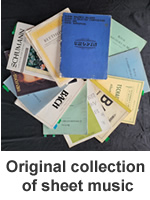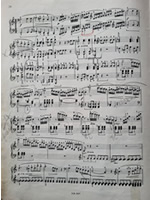"Shades of Donna" is a tribute album to my dedicated
childhood classical piano teacher Donna Gobin.
Donna taught piano to a number of students in Kingston ON Canada for several
years. Unfortunately, she passed away at a relatively young age.
In recognition of her superb contribution to music, the Kingston Kiwanis Music
Festival has dedicated the Donna Gobin Memorial Rosebowl as
the highest award for excellence in piano.
I was fortunate to have studied under Donna Gobin. I regret that I never took
the time to properly thank her for her years of encouragement, dedication and attention
to detail.
Since she has continued to be a huge influence throughout my life, I decided
to record the pieces below that she either taught me or inspired me to learn.
 |
If you look at any page of my original sheet
music you will notice that Donna Gobin marked up several of her own suggested
changes to tempo, dynamics, fingering, phrasing, pedalling and more making
the piece really her interpretation.
Yet, this was incredibly helpful to me to understand how one can use
interpretation to add a personal touch to a series of notes on a page.
|

|
When I learned Chopin's Raindrop Prelude, I only knew Donna's
interpretation. There was no internet and I had never heard it on an album.
She taught me to take a very slight "breath" before that single high
Bb at 4:22, then hold it before gently coming down the waterfall getting softer
and softer paying no attention to the time signature. So, that's the way I have
always played it. Shortly after that, I heard another performance of the Raindrop
Prelude and I remember thinking, "Well, that's not how it goes!". Since
then, I have listened to dozens of other versions and I now recognize
that many professionals take liberties with that phrase (and the entire piece
for that matter) but I still prefer Donna's interpretation.
Some of her “rules” that I remember include that you must memorize
each hand separately before you put them together. This is not an easy
task as one hand often relies on the other hand for timing and expression cues.
Another rule was that we were not allowed to use sheet music for the exam even
though the Conservatory allowed that. This added to the student’s complete
knowledge of each piece. If you truly know something for memory then you are
more likely give a stronger performance than if you are relying on reading it.
I completely agree!
Ludwig Van Beethoven (1770-1827): Sonatina in G Major - This
Sonatina introduces young students to the use of grace notes and crescendos
and decrescendos to accompany beautiful phrases.
Isaak Berkovich (1902-1972): Etude No. 21 in F Major - This
étude has a simple single note left hand melody, a perfect introduction
to students learning classical piano.
Christian Petzold (1677-1733): Minuet in G Major - (First
attributed to J.S. Bach (1685-1770)). This minuet adds several musical ornaments
such as trills and grace notes to accompany a lovely melody.
Carl Czerny (1791-1857): Etude in C Major, Op. 261, No. 3
- Toronto’s Royal Conservatory of Music Syllabus includes numerous Czerny
études. Donna Gobin taught me several of them. This one is not difficult
and fun to play!
Robert Schumann (1810 – 1856): First Sorrow, Op. 68
- From "Album for the Young". A touching piece where Schumann's music
reveals the sadness, disbelief and anger often associated with a first loss.
Schumann: The Wild Horseman, Op. 68 - A challenging piece
for any young pianist. Note how each hand takes turns playing the melody.
Schumann: The Happy Farmer, Op. 68 - Once again Schumann offers
a chance for each hand to carry the melody in this cheerful piece.
Muzio Clementi (1752-1832): Sonatina in C Major, Op. 36, No. 3
- Clementi uses this sonatina to teach the importance of the evenness of the
notes in the long major scale phrases and it includes a wide variety of dynamics
to challenge the pianist.
Frédéric Chopin (1810-1849): Prelude in E minor, Op.
28 No. 4 - Donna Gobin introduced me to Chopin who became my favourite
composer. This beautiful prelude illustrates how Chopin is a master of chromatic
harmony. By Chopin's request, the piece was played at his own funeral.
Henri Bertini (1798 – 1876): Etude in F Major - Bertini
uses this étude to teach dexterity in the predominant left hand melody
with two brief right hand contributions.
Henry Lemoine (1786 – 1854): Etude in G Major - This
étude is an exercise on how to play the melody using thirds with a variety
of staccato and legato phrases.
Czerny: Etude in C Major, Op. 299, No. 4 - Part of Czerny’s
“School of Velocity” where he focuses on speed, dexterity and evenness
of the notes!
Johannes Brahms (1833 – 1897): Waltz in A-Flat Major, Op. 39,
No. 15 - Many of us are familiar with Brahms Lullaby. Here is another
beautiful Brahms waltz with some romantic crescendos.
Pyotr Ilyich Tchaikovsky (1840-1893): Neapolitan Dance, Op. 39, No.
18 - Tchaikovsky challenges the student to play repeated accompaniment
notes quickly and effortlessly in this joyful dance.
Chopin: Prelude in B minor, Op. 28, No. 6 - This romantic
prelude features an almost entirely left hand melody. Donna Gobin impressed
upon me her interpretation of tempo, phrasing, touch and nuance.
Friedrich Kuhlau (1786 – 1832): Sonatina, Op. 55, No. 6 -
This Grade 8 Sonatina has everything bundled into 4 pages; dynamics, scales,
arpeggios, crossing of the hands, speed and major and minor keys.
Jacques Ibert (1890 – 1962): The Little White Donkey (Le petit
ane blanc) - The left hand sets the trotting tempo of a playful Donkey.
Donna Gobin used to remind me “It’s a donkey, not a race-horse!”.
Chopin: Raindrop Prelude, Op. 28, No. 15 - Perhaps the most
beautiful and most recorded Chopin prelude of all time. Note throughout the
piece the repeating Ab, which sounds like raindrops to many listeners. This
piece was played at Donna Gobin’s funeral in 1979.
Beethoven: Six Variations on a Theme - Beethoven takes a simple
theme and twists it into a number of clever variations. A challenge and a delight
to learn.
Christoph Willibald Gluck (1714 – 1787): Melodie from Orfeo ed
Euridice - My Uncle Ross Johnson played this beautiful piece at a concert
in Toronto in 1978. I have ended this album with a piece that Donna didn't teach
me but inspired me to learn.
All of the pieces were recorded on this beautiful Yamaha C3X Grand Piano. Here
are some comments from listeners.
Thanks to my mother Helen Ruth MacLachlan who supported my
interest in music during her life.
Thanks to my wife Christine for her encouragement and support
throughout this project.
Thanks to Brian Losch for his superb production.
https://www.brianlosch.com/
|